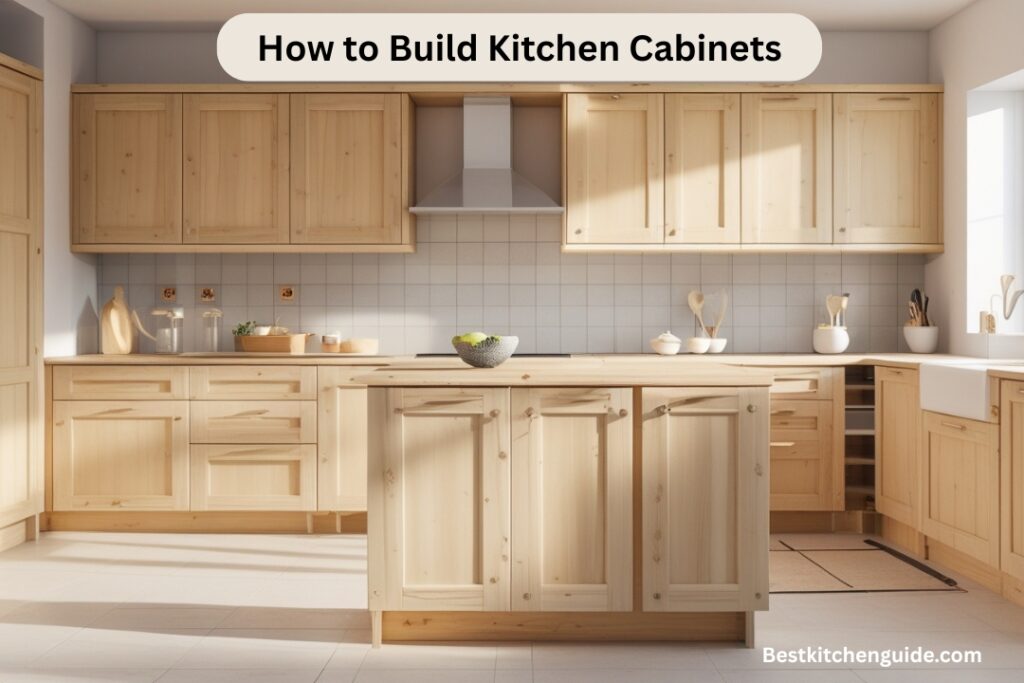A guide on how to build kitchen cabinets using plywood boxes, glue, screws, and face frames, ensuring everything is square, sturdy, and level. Learn more

Why Build Kitchen Cabinets Yourself?
There are several good reasons why homeowners decide to build their kitchen cabinets from scratch:
- Cost savings: Custom cabinets can be costly when ordered from professional shops. Building them yourself can reduce expenses dramatically, especially if you already have access to tools.
- Customization: DIY cabinets can be built to fit unusual kitchen layouts, unique storage needs, or specific design preferences that mass-produced options might not offer.
- Pride and satisfaction: Few home improvement projects are as fulfilling as building functional, beautiful cabinetry with your own hands.
Of course, the process does require time, patience, and fundamental woodworking skills. But do not worry — you do not need to be a professional carpenter to build cabinets you will be proud of. For more expert tips and guides, be sure to visit Best Kitchen Guide.
Plan Your Cabinet Project
As with any significant DIY effort, planning is critical to success. Rushing into a cabinet build without a clear plan will almost always lead to mistakes or wasted materials.
Measure Your Kitchen Carefully
Start by measuring every part of your kitchen that will host cabinets. Be meticulous — even minor inaccuracies can cause big headaches later. Note the positions of appliances, windows, doors, outlets, and plumbing fixtures. Record ceiling heights and floor level variations, as they can affect your cabinet heights.
Choose Your Cabinet Style
There are two primary styles of kitchen cabinets:
- Framed cabinets: These are common in traditional kitchens. They have a face frame attached to the front edges of the cabinet box.
- Frameless cabinets (Euro-style): These have no face frame and offer a sleek, modern look with slightly more interior storage space.
Your choice here will guide the design of your cabinet boxes, doors, and drawers.
Sketch or Use Design Software
Create detailed sketches of each cabinet unit, including dimensions, shelf placements, and door swing directions. You can do this by hand or use free online cabinet design tools. This will help you visualize the project and spot any issues before building.
Gather Materials and Tools
The materials you choose will determine how durable and attractive your cabinets will be. Here is what you will need:
Common Materials
- Plywood (¾-inch): Ideal for cabinet sides, bottoms, tops, and shelves due to its strength and stability.
- Hardwood (maple, oak, birch): Often used for face frames, doors, and drawer fronts.
- ¼-inch plywood or hardboard: Suitable for cabinet backs or drawer bottoms.
Tools You Will Need
- Circular saw, or table saw for cutting panels.
- Drill and driver set for assembly.
- Pocket hole jig (optional, but highly recommended for clean joints).
- Clamps (the more, the better).
- Sander or sanding block.
- Wood glue, screws, brads or nails.
- Tape measure, square, level, and marking tools.
Do not forget your safety gear: goggles, ear protection, and dust mask.
Build the Cabinet Boxes
With your materials cut to size, you can begin assembly.
Cutting Components
Cut all parts for each cabinet:
- Sides
- Top and bottom
- Back panel
- Shelf panels
- Toe kick base (for floor cabinets)
Cutting all pieces for one cabinet at a time is best to avoid confusion and mistakes.
Assembly
Lay out your side panels and mark where the top, bottom, and shelf supports will go. Apply wood glue at the joints, then fasten using screws or pocket holes. Double-check for square before the glue dries.
The back panel is typically attached last, helping to square up the box. Depending on the thickness of your material, use nails, staples, or screws.
Tips for Success
- Assemble on a flat, level surface to keep everything square.
- Use corner clamps to hold panels in place as you fasten them.
- Wipe away excess glue immediately to avoid staining later.
Add Shelves and Dividers
Depending on your design, you may have fixed or adjustable shelves.
- For fixed shelves, attach them with glue and screws, making sure they are level.
- For adjustable shelves, drill holes along the inside edges of the cabinet sides to hold shelf pins.
Dividers, such as pull-out trays, trash bins, and spice racks, can be added for specialized storage.
Build and Install Doors and Drawers
Building Doors
Cabinet doors can be:
- Slab style: A flat panel, often made from plywood or MDF.
- Shaker style: A simple frame with a recessed centre panel.
- Raised panel: More decorative, with a profiled central panel.
Shaker doors are a popular DIY choice because they are simple to build and look great in many kitchens.
Cut the frame pieces, assemble with glue and pocket screws, and insert the panel. Sand all edges smooth.
Building Drawers
Drawer boxes are typically made from ½-inch or ⅝-inch plywood. If you are feeling ambitious, use strong joinery such as pocket screws, dadoes, or dovetails. Install drawer slides carefully so drawers operate smoothly and fit correctly.
Sanding and Finishing
Before you apply any finish:
- Sand all surfaces with 120- to 220-grit sandpaper.
- Fill any nail holes, screw holes, or gaps with wood filler.
- Sand again after the filler dries for a smooth finish.
Choose a finish that suits your style:
- Paint for a crisp, modern look.
- Stain and clear coat to enhance the wood grain.
Apply multiple thin coats, sanding lightly between coats for best results.
Install Your Cabinets
Once finished, your cabinets are ready to install.
Wall Cabinets
- Mark the wall stud positions and draw a reference line with a level.
- Start with the corner cabinet and work outward.
- Use shims where needed to keep everything level and plumb.
- Secure through the cabinet back into wall studs with long screws.
Base Cabinets
- Begin with the corner or sink base.
- Use shims to ensure cabinets are level on uneven floors.
- Clamp cabinets together as you install to align the faces.
- Fasten through side panels to connect neighbouring cabinets securely.
Helpful Tips for Building Kitchen Cabinets
- Always pre-drill screw holes to prevent the wood from splitting.
- Work slowly and carefully during the planning and cutting stages — this saves far more time than fixing mistakes later.
- Label all parts before assembly so you do not mix up pieces.
- Ask for help lifting and installing large cabinet units to prevent injury and ensure accuracy.
Final Thoughts
If you found this helpful guide, explore our other DIY woodworking and kitchen upgrade articles for more inspiration and practical advice!
Learning how to build kitchen cabinets is a profoundly satisfying experience that combines craftsmanship, creativity, and problem-solving. While it takes time and effort, the result is a kitchen that reflects your unique vision and perfectly serves your needs. From precise planning to the final coat of finish, each step brings you closer to a custom kitchen you can proudly say you built with your two hands.
